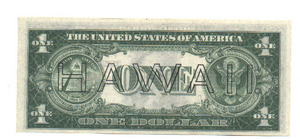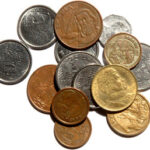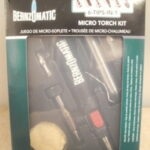When the 60th anniversary of the end of World War II occurred in 2005, a good number of currency and coin dealers your writer regularly speaks to track industry trends, reported a spike in customer interest for paper currency species with a connection to the war years. The two most frequently mentioned items, were: 1) the HAWAII imprinted silver certificates and Federal Reserve notes, issued in July, 1942 and; 2) the yellow Treasury Seal notes issued in advance of Operation Torch, the invasion of German occupied North Africa in November, 1942, and also used in the Sicily campaign which followed.
I was aware of these notes years earlier because of my extensive research while writing my best-selling 1982 Harper & Row book “The World War II Quiz & Fact Book,” and its 1984 sequel, Vol. 2 of the same title. Furthermore, I also included these ’emergency currency’ notes in my 1989 coffee-table tome “World War II Flashback,” and again in my 2001 book “Pearl Harbor Amazing Facts (ISBN 0971056005)” the only one of the four titles still in print.
These notes ring true the cliché about “holding history in your hands” as they represent genuine wartime issued mementos from a bygone era. Such notes continue to be legal tender and, at least in Hawaii where a few large hoards have been discovered in recent years, many Hawaiians believe so much of it was printed that they are still easy to come across in circulation.
Easily recognizable because of the large HAWAII overprint across most of the reverse of these emergency currency notes used in the Pacific and South East Asia areas, the seal and serial numbers on both the silver certificates and Federal Reserve Notes were imprinted in brown ink and a much smaller, but bold, HAWAII was imprinted vertically in two places on the obverse near the outside decorative bordering at both ends. Regular U.S. currency was prohibited from circulation in Hawaii until October, 1944, though it was widely believed in Washington and Hawaii that the threat of a Japanese invasion had not been a concern for more than a year.
During the war the Treasury Department authorized the destruction of worn-out currency in Hawaii instead of the risk involved in shipping it to the mainland for destruction. The records of the Special Treasury Destruction Committee in Honolulu relate to destruction of unfit currency, and plans for destruction of currency and securities in case of emergency. This precautionary step was deemed unnecessary for badly worn North Africa emergency currency. Both the HAWAII and North Africa emergency currency replacement notes, in all theaters of operation, were indicated with a star.
Remarkably, the only distinguishing feature on the emergency currency produced for the North Africa campaign was the yellow printing of the traditionally blue seal.
In preparation for and during the North Africa Campaign in late 1942, U.S. troops were paid in the yellow seal emergency currency. This was done for the same reason the HAWAII notes were introduced in the Pacific, namely to prevent German and Italian troops from capturing useable U.S. currency. To a lesser degree than the several distinctive markings on the HAWAII currency, the North Africa special currency could nonetheless be easily be identified and declared worthless if seized by Axis troops.
North Africa notes resemble regular issue Silver Certificates with blue serial numbers, but the yellow Treasury Seals were printed on the 1935A series, valued today in average condition at $6-$10. Yellow Seal average condition 1934A series $5 notes are worth $8 to $20. The $10 yellow seals, also series 1934A range from, $15 to $20. The rarest and most valuable of the North Africa notes are the 1934 $10 yellow seal which, depending upon condition, can bring $300.
The December 7, 1941 carnage and devastation was still being tended to at Pearl Harbor, Oahu, Hawaii when naval, air, and infantry forces of Japan invaded the Philippines. They overran Manila on January 2, 1942, and in the process captured more than $20.5-million in U.S. and local cash and an unknown amount of foreign currency and bullion in that capital city.
In Hawaii, and at the Pentagon in Washington as well, there was concern and alarm that Japan’s Kido Butai (Pearl Harbor attack fleet) would return and invade the Hawaiian Islands some 2,000 miles from the U.S. West Coast. All over Hawaii people began hoarding cash and hiding it.
The same day the Japanese hit the jackpot in Manila, the U.S. declared it was illegal for individuals in Hawaii to have more than $200 in cash. Businesses could keep $500. So strong were the invasion fears during the days and weeks after December 7, that military dependents and other U.S. citizens from the mainland were being shipped and flown away from the nine inhabited islands (out of the twenty volcanic islands which made up the archipelago) in what amounted to a panic exodus-like stampede. In most cases, departing civilians needed little encouragement to close local bank accounts and sell things of value, such as cars, and take millions of dollars in U.S. currency with them.
With few exceptions, the only non-military personnel who didn’t leave were the several thousand native born Hawaiians and the large Japanese population who lived and worked in the islands they called home.
Meanwhile, civilian traffic going to Hawaii, and into harm’s way, was brisk as thousands of U.S. civilians in the construction trades, steel workers, electricians, heavy equipment operators, and hardhat divers, etc., volunteered to leave the peace and security of the U.S. mainland and come to Hawaii to help repair the damaged U.S. fleet.
Washington recognized that this sizeable post-December 7 population in Hawaii (military, locals and civilian emergency workers) required a sound economic base for conducting the daily uninterrupted intercourse of commerce. Since the United States wouldn’t introduce Military Payment Certificates until after World War II was over, everything bought or paid for during the war years, by military personnel and civilians alike, was in hard cash.
Consequently, the U.S. government jump-started a contingency economic defense plan for replacing the normal legal tender notes with the aforesaid specially marked and easily identifiable new emergency currency issues for $1; $5; $10; $20 silver certificates and Federal Reserve Notes. The logic was simple: if an enemy captured a depository, bank or money reserve, the U.S. could immediately demonetize the specially printed, and easily identified, notes making them worthless to the enemy.
The $1 HAWAII notes are series 1935A and worth $3 to $8. HAWAII $5 notes, issued in the 1934 and 1934A series, are usually in the $8 to $15 range. The $10 HAWAII was from the 1934A series and Typically commands between $15 to $20 in average condition, while the $20 sells for upwards of $80.
In order to facilitate an orderly exchange, rather than a panic, of regular U.S. currency for the emergency HAWAII notes, the government set August 15, 1942 as the deadline for conversion, and held its collective breath hoping the aggressive Japanese wouldn’t dare invade before then.
While researching an earlier version of this article in 1977 for The Palisadian newspaper (NJ), this writer was confronted with information supporting two popular scenarios of what became of all the regular U.S. currency in Hawaii after the Japanese attack.
According to a frequently repeated and reported version, when everyone in Hawaii was directed to turn in cash and securities, an astonishing $200 million+ was gathered. Someone in the government determined it would be better to burn it all than risk it falling into Japanese hands.
As a result, this fortune in spendable U.S. greenbacks was reportedly taken to the Nuuanu Mortuary on Oahu, but the crematory quickly determined it was unable to dispose of such an extraordinarily large amount of paper in the proscribed time. So what the mortuary couldn’t handle allegedly went up in smoke at the Aiea Sugar Plantation mill.
Despite the above, other sources swear that even before the July issuing of HAWAII notes and the August 15 deadline, regular U.S. currency was being collected and shipped back to the U.S. mainland almost on a daily basis. At times the SS Lurline, and Matson Line’s other three passenger cruise ships that plyed the Pacific, had so much money and valuables on board en route to the mainland from Hawaii that they were huge floating treasure chests that would have caused sea-going pirates of yesteryear salivate.
On December 7, the Lurline was on her usual run from Honolulu to San Francisco when she received news about the attack and immediately began to zigzag and diverted from its normal course. She arrived in the ‘City By The Sea’ on December 10. The next day Matson’s famed four white ships were handed over to the U.S. Maritime Commission, painted wartime gray and transformed into troop transports. Nonetheless, rumors persist to this day that at least one Matson passenger ship collected and evacuated civilians carrying a small fortune in cash from Hawaii.
But watching Hawaii’s famous Diamond Head landmark fall below the horizon from a ship headed for San Francisco didn’t mean the people aboard were out of peril. Japanese submarines were known to ply these waters, even to within sight and range of the U.S. coast. In fact, in February, 1942 A Japanese submarine fired 13 shells at the Bankline Refinery at Goleta in Southern California, and in two other separate incidents Japanese submarines shelled the harbor defenses of the Columbia River in Washington state and a military depot at Fort Stevens, Oregon.
The reason for the regular-to-emergency currency exchange in Hawaii was because of a Marshal Law edict, which Hawaii had been under since the day of the attack. It was ordered that no U.S. currency other than the emergency notes could be held by anyone in the islands unless they had a good reason and obtained a difficult to get special permit.
I located historical document references for doing this in a document that was included in existing overall U.S. War Plans procedures, and further included as an addendum to the specific “Orange” War Plans. Orange was the U.S. peacetime codename used to identify Japan if war broke out (NOTE: all nations have war plans detailing what to do against potential or possible enemies in the event of hostilities). The inclusion of emergency currency provisions, based on previous historical events in other wars, had been supported by documents in the U.S. Treasury Department file archives.
The value of currency and financial planning provisions had become abundantly clear when war began in Europe in September, 1939. Several countries immediately and frantically shipped their gold bullion reserves and large amounts of currency notes to the U.S. and Canada in a rescue program codenamed Operation Fish. As it does with everything in peacetime, money fuels war machines and capturing the legal tender of any nation is always high among an invading enemy’s priorities.
The U.S. plan to demonetize any captured wartime emergency currency offered the government the protection of preventing any benefit to the enemy, but not protection for the local individuals whose money was confiscated.
Meanwhile, during the war $1 Silver Certificates were also the subject of government experiments with new paper formulas. Notes printed on the experimental paper had an “S” imprinted in the lower right corner. At the same time a like number of $1 bills printed on traditional paper displayed an “R” in the same location. A total of 1,184,000 notes were printed for each type. Still occasionally found in circulation, to the best of this writer’s knowledge, no results for the experiment were ever released. These S and R Silver Certificates are worth between $10 to $20 in average condition.
In recent years occasional newspaper stories still tell of people accidentally finding hidden hoards of HAWAII emergency currency in the islands. In 1980 a man painting an attic discovered $100,000 represented in a total of 1,793 bills ranging from $1 to $20. In a lesser, but more recent revelation, an elderly woman who had accumulated some $45,000 in HAWAII currency, mostly $20 bills, asked a banker how she should go about selling them. The advice she was given was she should spend the money since the bills were not new and crisp they were simply worth face value, because currency collectors only wanted unused, unfolded money!





